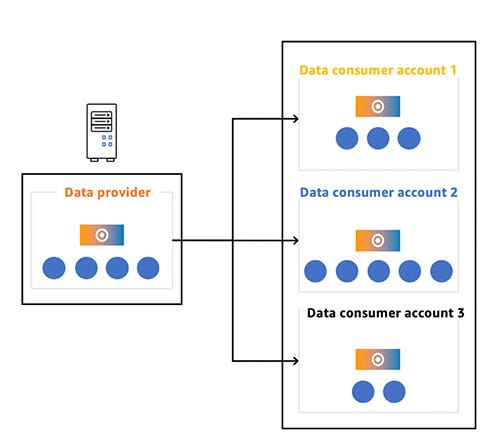TCP #36: Redshift Datashare: Share Data, Not Storage Costs
Ready-to-use scripts and best practices inside...
Organizations waste millions on redundant data storage and countless hours on data synchronization.
Amazon Redshift Datashare offers a better way: real-time data sharing without the complexity or cost of data duplication.
This comprehensive guide gives you the exact scripts and best practices to implement Datashare across your organization, whether you share data between departments, AWS Accounts, or external partners.
In today’s newsletter, I will cover:
What is Redshift Datashare?
Why this feature matters for modern data sharing
Key business benefits and use cases
Understanding Redshift Datashare Architecture
Setting Up Cross Account Datashare (From my real-world experience, don’t miss it!)
Advanced Datashare Features
Best Practices and Common Pitfalls
Business Impact Analysis
What is Redshift Datashare?
Redshift Datashare represents a paradigm shift in how organizations handle data sharing within and across AWS accounts.
At its core, it's a feature that allows you to share live, read-only data across different Redshift clusters without complex ETL processes or data duplication.
Think of Datashare as a virtual bridge between different data environments.
Instead of copying data from one place to another, you're creating secure viewing windows into your data. This is particularly powerful because it maintains a single source of truth while allowing multiple teams or organizations to access the same data in real time.
The business impact is significant: marketing teams can access sales data without waiting for daily exports, partner organizations can see relevant inventory data in real time, and data scientists can work with production data safely in development environments.
This real-time access to data, combined with eliminating data movement and storage costs, can translate into substantial operational improvements and cost savings.
Understanding Redshift Datashare Architecture
The architecture of Redshift Datashare follows a producer-consumer model.
The producer cluster owns the original data and controls what is shared, while consumer clusters can read but not modify the shared data. This model ensures data integrity while maintaining flexible access control.

Here's how the workflow operates:
The producer cluster creates a datashare and specifies which objects (tables, views, functions) to include
The producer then grants access to specific consumer clusters or AWS accounts
Consumer clusters create databases from the datashare
Users in consumer clusters can query the shared data as if it were local
A key architectural advantage is that data isn't copied between clusters. Instead, Redshift maintains metadata about shared objects and routes queries appropriately. This approach ensures data consistency and eliminates storage duplication costs.
Setting Up Cross Account Datashare (From my real-world experience)
Use case: Cross-account real-time access to ETL output data
This week, I had to set up cross-account datashare on the Redshift cluster to make data available to another team using a different AWS account.
Keep reading with a 7-day free trial
Subscribe to The Cloud Playbook to keep reading this post and get 7 days of free access to the full post archives.



